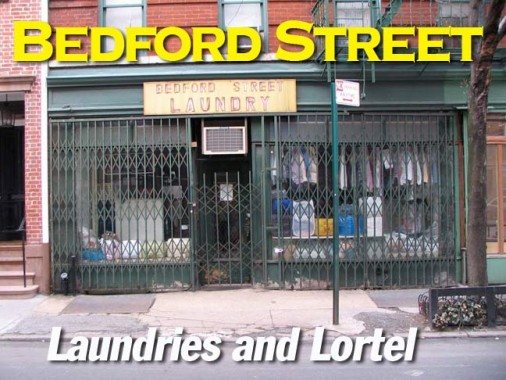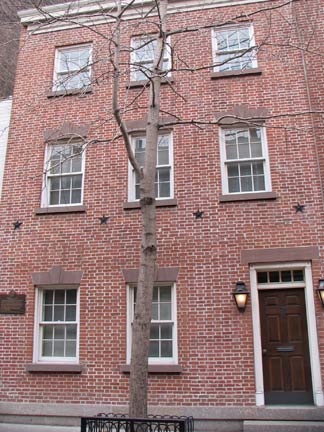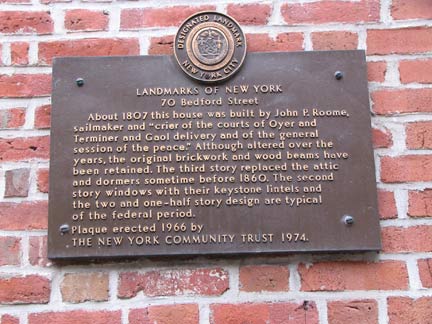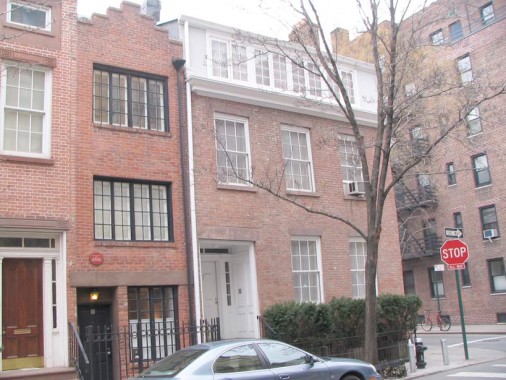“Bedford” is perhaps a better-known appellation on Brooklyn, where Bedford Avenue is the borough’s longest, running from Greenpoint to Sheepshead Bay, or the Bronx, where Bedford Park borders Fodham University and the NY Botanical Gardens. Bedford Street is one of Greenwich Vilage’s more unsung throughfares, running northwest from 6th Avenue and Houston Street to Christopher. The origins of the name are somewhat hazy: both Henry Moscow (The Street Book) and Sanna Feirstein (Naming New York) say it was named for Bedford Street in London (in Westminster), though neither knows why.
70 Bedford, south of Commerce Street, was given its own historical plaque in 1966; as it says, it was constructed in 1807 by sailmaker and court officer John P. Roome.
Two of the Village’s more fabled buildings are side by side across the street. In a house so narrow it rates only half an address, is 75-1/2 Bedford Street, a house only 9-1/2 feet wide. Shaquille O’Neal might have a hard time laying down on the floor. There used to be stables inside the block adjacent to the Isaacs-Hendricks House, and the narrow building was constructed in 1873 on what used to be the carriageway entrance. Famed poet Edna St. Vincent Millay lived in the building briefly in 1923-24. (Beat-era novelist William Burroughs lived at 69 Bedford, a few doors down, in the 1950s.)
Next door, on the corner of Commerce, is 77 Bedford, the oldest building in Greenwich Village. Known as the Isaacs-Hendricks House, it was built in 1799 (before most of the Village streets had been laid out), although large sections of it including the brick facing were added in 1836, and the third floor is practically new, since it was added in 1928. The Isaacs-Hendricks House is a former farmhouse owned by Harmon Hendricks, a copper merchant who supplied Robert Fulton with materials for copper boilers that powered the historic Clermont steamboat run in 1807.
Chumley’s, at 86 Bedford near Barrow, is writing a comeback story, albeit very slowly. The site of the ForgottenBook launch party in September 2006, the place suffered The Curse of Your Webmaster* the following year when one of the interior walls collapsed, forcing a reconstruction. Chumley’s has been first a speakeasy and then a literary hangout for decades, with hundreds of framed book jackets hung on the walls, including mine. Chumley’s hopes for a 2009 relaunch.
*Forgotten hangouts like the Waterfront Crabhouse, Long Island City (fire), Tibbett Diner, Bronx (fire), Cheyenne Diner, Penn Station area (closed), and others had all fallen on hard times. Can Millard Fillmore’s of Flushing survive?
89 and 91 Bedford Street. Poet Delmore Schwartz was a former resident at 91.
At 95 is a ground-floor former stablesbelonging to J. Goebel & Co., whose name and symbol is still displayed above the entrance. The 3 cups are appropriate, since he operated a crucible in the building.
PS 3, occupying part of the block between Hudson, Bedford, Grove and Christopher Streets is so large it had to be built to accommodate the curve in Grove Street. It has been here for a long time — the Marquis de Lafayette visited PS 3 during his trumphal tour of the United States in 1824, as the plaque facing Hudson Street attests.
A 1917 “time capsule” created by school alumni was recently opened:
The copper box had a couple of medals that were given to alumni and to graduating students, as well as programs from a few annual [former principal] B.D.L. Southerland Association dinners. School songs and engravings of the long-bearded Southerland were among the contents, along with a roster of distinguished old graduates.
The historical outline chronicles the school from 1818 when it opened with 51 pupils in a building on Trinity Parish property acquired by the Free School Society. It grew to 200 students, and in 1820 the Free School Society built a new building, which served boys and girls. In 1860, a new brick and stone structure replaced the previous building.
In the early days, Grammar School 3 was famous for its special “sand system” writing program, consisting of a 15-foot-long wooden box 6 inches wide with the bottom stained black and covered with a thin coat of sand. Students would practice their penmanship writing in the sand –uncovering the black bottom — with a wood stylus as thick as a goose quill. It was such a remarkable device that General Lafayette came to inspect it in 1824, according to the historical sketch. The Villager
Some folks think this frame house on the corner of Grove and Bedford Streets is the oldest in the Village (as opposed to the Isaacs Hendricks House). It’s pretty old alright, but there are a fair number that are older. Frame houses are relatively rare in lower Manhattan.
Window sash maker Thomas Hyde built it in 1822 and, typically of houses built at the time, it had only two stories when built, with the third going up in the 1870s.
Next door at 102 Bedford Street, an 1830 townhouse was renovated beyond remembering in 1925 by Clifford Daily with help from financier Otto Kahn. Daily, an amateur architect, considered the surrounding buildings mundane and wanted to liven things up. But Kahn took over the building and offered Daily $5000 to clear out. Daily reluctantly agreed, but vowed to someday return. The story goes that he plunged two bottles of champagne in wet cement in the basement and said he would break them out when he returned to Twin Peaks. The bottles are still waiting.
At Christopher Street: Lucille Lortel, known as the Queen of Off Broadway, could also be called the Queen of the 20th Century; she was born in 1900, and died in 1999. The old Theatre de Lys, in a building constructed in the 1860s, was acquired by Miss Lortel in 1955 — independently wealthy, she brought works by American playwrights such as McNally and Albee and Europeans Genet, Ionesco and many others to prominence for the first time in the USA. The de Lys was renamed for Lucille Lortel in 1981. There is a mini-walk of fame outside the theatre featuring famed playwrights.
Photographed March 15; page completed March 23, 2009



